Pretty much everyone understands full and incremental backups in NetWorker. A full backup is a backup of everything, and an incremental is a backup of everything that has changed since the last backup, regardless of what level that is.
On the other hand, differential backups can sometimes throw people out for a while longer; particularly since NetWorker is more flexible and offers 9 differential levels.
I like to visualise backup levels as follows:
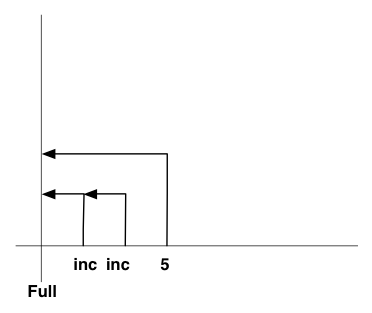
This represents a full backup (which is drawn as a “line in the sand”), two subsequent incrementals, and a level 5 backup following the second incremental.
The first incremental backs up everything that has changed since the previous backup, which in this case is a full, thus the end-point for its arrow is the full backup line. The second incremental again backs up everything that has changed since the previous backup – the first incremental. As such, its arrow end-point is the first incremental backup.
Finally, the level 5 backup bypasses the incrementals and backs up everything that has changed since the full, so its arrow end-point goes all the way back to the full.
If you’re wondering about what makes the differential level 5 significant there – nothing. It doesn’t matter whether you use a 5, 3, 2, 8, etc. The differential numbers only have significance when you use more than one of them in a single schedule. For instance, the above backup could have been equally achieved with:
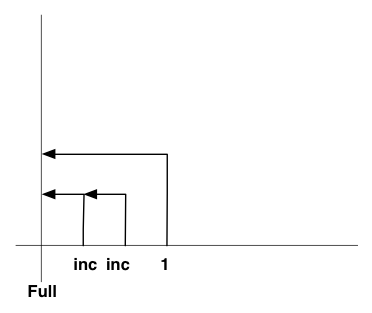
This allows us to establish our first set of criteria for differential levels:
Rule 1: If only using one differential level in a schedule, the number is irrelevant.
Guideline 1: If only using one differential level, start in the middle. That way, if you have to slot in another differential level later, you’ve got room on ‘either side’.
Differentials in NetWorker become more complex when you have more than one level involved. Let’s consider a slight change to the above level diagram:
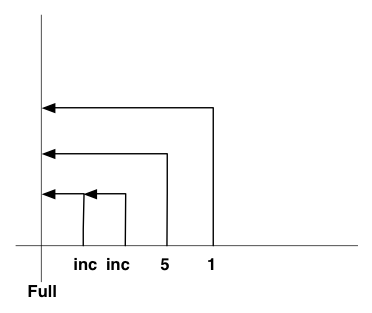
In this, we’ve got a fairly standard appearing set of levels until we hit the differential level 1; this follows a 5, and backs up everything that has changed since the full. If we turn to the nsr_schedule man page for a clarification here, we see:
“The levels 1 through 9 cause all files to be saved which have been modified since any lower level was performed. As an example, if you did a full save on Monday, followed by a level 3 save on Tuesday, a subsequent level 3 save on Wednesday would contain all files modified or added since the Monday full save.”
So this leads to our second set of criteria when dealing with differential levels:
Rule 2: Any differential level will backup all files which have been modified since any lower has been performed.
Guideline 2: Think of a full backup as ‘level 0’, and the differential rules make more sense.
Thus, if we swap around the two differential levels in the above diagram, our backup behaviour becomes markedly different:
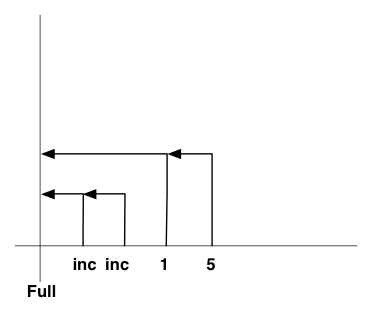
The behaviour up to and including the level 1 backup mirrors what we saw in figures 1 and 2 – incrementals going back to the full, and the first differential performed also going back to the full. However, the level 5 backup will only backup those changes which have occurred since the level 1 backup – 1 is lower than 5, so it will “cause all files to be saved which have been modified since any lower level save was performed” to be triggered when the 5 is run.
Our last example for consideration is what happens when we throw another differential level in; let’s go for a level 3:
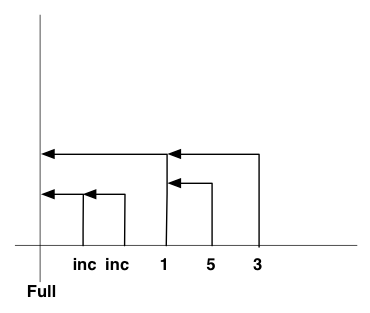
Focusing on the “since any lower level save was performed”, if we do a level 3 backup after the level 5, it too will backup all files that have changed since the level 1 backup, incorporating not only the changes in the level 5 backup, but any changes since that point.
To the uninitiated, NetWorker’s differential backups may seem a little challenging, but once you get the hang of them via the two sets of guidelines above, you’ll find they’re very straight forward.
Though that I was already understanding pretty weel the difference beetween incremental and level/Differential backup, This article did clariy a bit more with the graph you show.
Thanx !